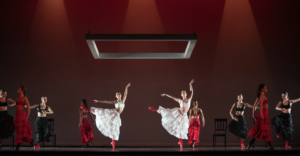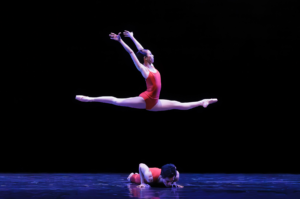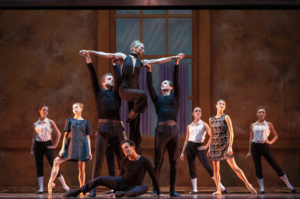City Ballet Soars in Premieres
Maurice Ravel didn’t intend for Bolero to be about sex. But the popular response to his 1928 composition—and of course the film “10”—have argued otherwise. Now there’s a fresh testament to the music’s erotic power: City Ballet of San Diego’s “Bolero—The Awakening,” which premiered at the Balboa Theatre last weekend. The ballet by company co-founder Elizabeth Wistrich sizzles.
The program offered new work from City Ballet choreographers Wistrich and Geoffrey Gonzalez, as well as the company debut of Christopher Wheeldon’s “Morphoses.” The Wistrich and Wheeldon pieces are triumphs, and Gonzalez’s “An American in Paris” looks swell though it disappoints as dance. The show plays again at the California Center for the Arts, Escondido on March 27.

Sumire Ito and Ariana Gonzalez lead the “Bolero” cast. Photo: Chelsea Penyak
Wistrich’s “Bolero—the Awakening” opens quietly, with just Ariana Gonzalez and Sumire Ito onstage. Initially only Gonzalez moves, striking elegant poses while Ito sits in a chair (one of six). There’s a sense of order in Gonzalez’s ballet-barre precision, the music’s martial beat, and the set: a large open square, like a picture frame, suspended above the stage. (There was no set design credit.)
Both women wear full skirts in virginal white. Ah, but their tights and slippers are red, as is Stephen Judson’s lighting. And their sinuous wrists hint at the passion of flamenco. As the music builds, they’re joined by six women in sparkly black skirts, then four in red. Everyone moves faster, doing sassy back-kicks, interweaving … yet often holding their arms in formal ballet poses. The corps de ballet’s discipline (a trademark of this company) enhances the juicy tension between restraint and abandon.
Cue the men. Five rush out. The black-skirted women stand on chairs and clap to the beat as the men do power moves. And are people stomping their feet, as Gonzalez partners with Iago Breschi and Ito flirtatiously eludes Lucas Ataide? Turns out the stomping is an added heartbeat sound; it’s overkill. On the other hand, Wistrich is having so much fun with Bolero’s dynamics—and its reputation—why not go all-out?
The music crescendos. The two couples do athletic overhead lifts. The background lighting is drenched in deep red. Even the suspended picture frame tips!

Ito leaps over Ataide. Photo: Julia Heibaum
The company has acquired many pieces that George Balanchine created for New York City Ballet. “Morphoses” is the company’s first piece by Christopher Wheeldon, who made the piece in 2002 as NYCB’s resident choreographer; he’s now Artistic Associate of the Royal Ballet and directs Morphoses/The Wheeldon Company.
Four dancers—Gonzalez, Ito, Ataide, and Brian Heil—at first seem a single creature, linking hands in dim light to the rising-from-the-ooze opening of Ligeti’s String Quartet No. 1, “Metamorphoses nocturnes.” (Mark Stanley and Stephen Judson did the lighting.)
Limbs, exposed in Holly Hynes’s streamlined red costumes, entwine. Backs undulate. Movement cascades in flexed ankles, angular joints, chest dives, lifts at contorted angles, brilliantly executed by these superb dancers. When Ito leaps over a prone Ataide—wow! I saw arachnids after an environmental catastrophe. My friend was reminded of Matisse. Isn’t dance wonderful?
Fun fact: Wheeldon choreographed “An American in Paris” for Broadway. Geoffrey Gonzalez did his take on the Gershwin classic for this show.
Gonzalez has been making dances for the company for several years, often abstract work, and I’ve found his choreography inventive and his sensibility nicely edgy, a bit dangerous. His “An American in Paris” is sunnier, and it may be the first Gonzalez work I’ve seen that tells an original story. It’s a stretch, an admirable one, and it doesn’t fully succeed.

Shannon Romeo (r) arrives in Paris! Photo: Julia Hiebaum
The story—inspired by American fashion designer Claire McCardell, who as a young woman studied in Paris—is thin, making me wish Gonzalez had consulted a dramaturg. The ingenue (Shannon Romeo, light-footed and charmingly fresh) brings her first creation, a pink Disney princess dress, to the Paris atelier, and is met by predictable disdain; then we see her in a sophisticated cocktail frock, and everyone’s celebrating.
The movement feels thin, as well, focused on character-establishing gesture. Fashion diva Megan Jacobs swans around, waving her cigarette (in a long holder) in the air. Models vamp, especially Heil, who has a blast in this role. Designers pose with mega attitude. In the final celebratory scene, dance reigns at last. It’s jazzy and fun, with quick feet, jutting hips, insouciant shoulder shrugs, and exuberant leaps by Romeo. I wanted more of that!

Megan Jacobs and her fashionistas. Photo: Chelsea Penyak
“An American in Paris” looks delightful. Gonzalez has a great eye for where to place his 20-member cast onstage. The costumes by Jannifer Mah are terrific: a girlish pink blouse and swingy skirt for Romeo’s ingenue, sleek black-and-white for the fashionistas, and several yummy cocktail dresses. Her final outfit for Romeo, which looked like a better-fitting version of my high school gym suit, baffled me, but Google revealed that McCardell created American women’s sportswear. Still, the gym suit seemed odd.
City Ballet of San Diego has never lacked ambition. Kudos to Gonzalez for venturing into new territory.

Award-winning dance journalist Janice Steinberg has published more than 400 articles in the San Diego Union-Tribune, Dance Magazine, the Los Angeles Times, and elsewhere. She was a 2004 New York Times-National Endowment for the Arts fellow at the Institute for Dance Criticism and has taught dance criticism at San Diego State University. She is also a novelist, author of The Tin Horse (Random House, 2013). For why she’s passionate about dance, see this article on her web site, The Tin Horse

Gershwin please? Thanks for mentioning Ravel.